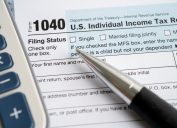IRS Warns 20% of Taxpayers Don't Claim Major Refund Credit—Are You Eligible?
The tax agency is urging filers to double-check for this often overlooked opportunity.

The 2024 tax season has just begun, and it's already causing headaches. All across social media, countless filers are finding out they owe money to the Internal Revenue Service (IRS) for the first time this year. But if you've found yourself in the same boat, you'll want to be sure you're taking advantage of every tax break you're eligible for. With that in mind, the IRS just revealed that there is one major refund credit that is often overlooked by taxpayers.
RELATED: IRS Announces Major Tax Filing Changes—Are You Affected?
In a Jan. 26 press release, the agency announced the annual launch of its Earned Income Tax Credit (EITC) Awareness Day. For 18 years, the IRS has partnered with community organizations, elected officials, state and local governments, schools, employers, and others for this outreach campaign designed to "help millions of low-to-moderate income working Americans" claim the EITC.
Around 23 million workers and families received about $57 billion in EITC refunds for the 2022 tax season, with an average amount of $2,451 in credit given to each filer, according to the agency's latest data. At the same time, the IRS warned that an estimated 20 percent of eligible taxpayers don't claim this major refund credit.
"The IRS and our partners across the nation urge people to look into this frequently overlooked tax credit that can help millions of taxpayers," IRS Commissioner Danny Werfel said in a statement.
He continued, "On EITC Awareness Day and throughout the filing season, the IRS and our partners work hard to reach eligible taxpayers and provide useful information and resources to help people determine their eligibility and how to properly claim this valuable credit. Even people who don't normally file might still be eligible for the Earned Income Tax Credit, which can be thousands of dollars."
The IRS also estimates that a third of those who qualify for the EITC in 2024 actually became eligible for the first time this year, according to the release. But to claim this credit, you must meet certain requirements and file a tax return—even if you're not normally required to file.
RELATED: IRS Warns That Claiming These Credits Can Get You Audited and Fined.
You may be eligible for the EITC if you pass all the following requirements: have worked and earned income under $63,398; have investment income below $11,000 in the tax year 2023; have a valid Social Security number by the due date of your 2023 return (including extensions); have been a U.S. citizen or a resident alien all year; and have not filed Form 2555 for Foreign Earned Income.
But the IRS also has special qualifying rules for military members and clergy members, as well as taxpayers and their relatives with disabilities. For taxpayers with qualifying children, you could receive a maximum refund of $7,340 when claiming the EITC on your 2023 tax return. This is a significant increase from the maximum of $6,935 in 2022, according to the IRS.
If you have three or more children with an adjusted gross income (AGI) of up to $56,838 as a single filer (or $63,698 for joint-filers), you are eligible to receive anywhere from $11 to $7,420 for your EITC. Taxpayers with two children and an AGI of up to $52,918 as a single filer (or $59,478 for joint-filers) can receive anywhere from $10 to $6,604, while those with one child and an AGI of up to $46,560 as a single filer (or $53,120 for joint-filers) can get a range of $9 to $3,995 back.
Qualifying workers without children are also eligible for up to $600 in EITC if they make less than $17,640 as a single filer or $24,210 as a joint filer.
You should be aware that claiming the EITC can delay your tax refund, however. The IRS said that most EITC filers won't receive their refund until Feb. 27, and that is only if they "chose direct deposit and there are no other issues with their tax return." If not, it could take even longer.
But you can check the online Where's My Refund? tool for your personalized refund date. The agency said the website should be updated with accurate projected deposit dates for most early EITC refund filers by Feb. 17.
Best Life offers the most up-to-date financial information from top experts and the latest news and research, but our content is not meant to be a substitute for professional guidance. When it comes to the money you're spending, saving, or investing, always consult your financial advisor directly.





















